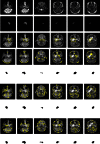Region-based nasopharyngeal carcinoma lesion segmentation from MRI using clustering- and classification-based methods with learning
- PMID: 22854973
- PMCID: PMC3649041
- DOI: 10.1007/s10278-012-9520-4
Region-based nasopharyngeal carcinoma lesion segmentation from MRI using clustering- and classification-based methods with learning
Abstract
In clinical diagnosis of nasopharyngeal carcinoma (NPC) lesion, clinicians are often required to delineate boundaries of NPC on a number of tumor-bearing magnetic resonance images, which is a tedious and time-consuming procedure highly depending on expertise and experience of clinicians. Computer-aided tumor segmentation methods (either contour-based or region-based) are necessary to alleviate clinicians' workload. For contour-based methods, a minimal user interaction to draw an initial contour inside or outside the tumor lesion for further curve evolution to match the tumor boundary is preferred, but parameters within most of these methods require manual adjustment, which is technically burdensome for clinicians without specific knowledge. Therefore, segmentation methods with a minimal user interaction as well as automatic parameters adjustment are often favored in clinical practice. In this paper, two region-based methods with parameters learning are introduced for NPC segmentation. Two hundred fifty-three MRI slices containing NPC lesion are utilized for evaluating the performance of the two methods, as well as being compared with other similar region-based tumor segmentation methods. Experimental results demonstrate the superiority of adopting learning in the two introduced methods. Also, they achieve comparable segmentation performance from a statistical point of view.
Figures





Similar articles
-
Computer-aided diagnosis and regional segmentation of nasopharyngeal carcinoma based on multi-modality medical images.Int J Comput Assist Radiol Surg. 2021 Jun;16(6):871-882. doi: 10.1007/s11548-021-02351-y. Epub 2021 Mar 29. Int J Comput Assist Radiol Surg. 2021. PMID: 33782844
-
Semi-supervised nasopharyngeal carcinoma lesion extraction from magnetic resonance images using online spectral clustering with a learned metric.Med Image Comput Comput Assist Interv. 2008;11(Pt 1):51-8. doi: 10.1007/978-3-540-85988-8_7. Med Image Comput Comput Assist Interv. 2008. PMID: 18979731
-
A Collaborative Dictionary Learning Model for Nasopharyngeal Carcinoma Segmentation on Multimodalities MR Sequences.Comput Math Methods Med. 2020 Aug 28;2020:7562140. doi: 10.1155/2020/7562140. eCollection 2020. Comput Math Methods Med. 2020. PMID: 32908581 Free PMC article.
-
Principles and methods for automatic and semi-automatic tissue segmentation in MRI data.MAGMA. 2016 Apr;29(2):95-110. doi: 10.1007/s10334-015-0520-5. Epub 2016 Jan 11. MAGMA. 2016. PMID: 26755062 Review.
-
Comparative Approach of MRI-Based Brain Tumor Segmentation and Classification Using Genetic Algorithm.J Digit Imaging. 2018 Aug;31(4):477-489. doi: 10.1007/s10278-018-0050-6. J Digit Imaging. 2018. PMID: 29344753 Free PMC article. Review.
Cited by
-
Fully Automated Delineation of Gross Tumor Volume for Head and Neck Cancer on PET-CT Using Deep Learning: A Dual-Center Study.Contrast Media Mol Imaging. 2018 Oct 24;2018:8923028. doi: 10.1155/2018/8923028. eCollection 2018. Contrast Media Mol Imaging. 2018. PMID: 30473644 Free PMC article.
-
DCNet: Densely Connected Deep Convolutional Encoder-Decoder Network for Nasopharyngeal Carcinoma Segmentation.Sensors (Basel). 2021 Nov 26;21(23):7877. doi: 10.3390/s21237877. Sensors (Basel). 2021. PMID: 34883878 Free PMC article.
-
BSMM-Net: Multi-modal neural network based on bilateral symmetry for nasopharyngeal carcinoma segmentation.Front Hum Neurosci. 2023 Jan 10;16:1068713. doi: 10.3389/fnhum.2022.1068713. eCollection 2022. Front Hum Neurosci. 2023. PMID: 36704094 Free PMC article.
-
Automatic Nasopharyngeal Carcinoma Segmentation Using Fully Convolutional Networks with Auxiliary Paths on Dual-Modality PET-CT Images.J Digit Imaging. 2019 Jun;32(3):462-470. doi: 10.1007/s10278-018-00173-0. J Digit Imaging. 2019. PMID: 30719587 Free PMC article.
-
Novel Preprocessing-Based Sequence for Comparative MR Cervical Lymph Node Segmentation.J Clin Med. 2025 Mar 7;14(6):1802. doi: 10.3390/jcm14061802. J Clin Med. 2025. PMID: 40142614 Free PMC article.
References
MeSH terms
LinkOut - more resources
Full Text Sources
Medical

